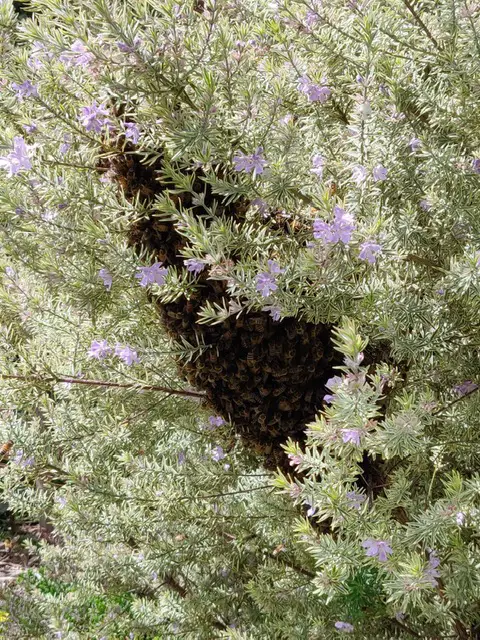A swarm is a natural phenomenon that occurs when a large group of flying insects, such as bees, collectively decide to move location in unison. Bees within a hive may think there’s not enough room for the colony to grow, so approximately half decide to leave and find a new home elsewhere.
However, when this occurs, some of the swarming bees can get left behind along the way. This article will explain why.
Bees Swarm As A Natural Means Of Reproduction
Bees swarm to ensure the survival and expansion of the colony. One of the major triggers for the colony to swarm is overcrowding.
During Spring, when days lengthen and nectar becomes more plentiful, the queen begins laying many more eggs. She typically lays between 1,000 and 2,000 each day, to ensure the colony will have enough bees to gather the available nectar and pollen. Soon the population increases and the hive becomes congested.
Sensing this, the workers build queen cells at the bottom of the brood frames. Between 6-8 queen cells are usually built, to ensure there is at least one strong enough to survive and become the new queen for the colony. The larvae inside are fed a special diet of royal jelly until each cell is capped.
The first of the new queens to emerge from her cell will eat some honey to gain strength. Then, she will locate the other queens and sting them to death before they emerge and can challenge her.
Two or three days before the emergence of the new queen, the colony prepares to swarm. About half the bees will leave with the old queen to find a new home, so they gorge on honey in preparation.
The swarm leaves the hive with the old queen and lands nearby in a cluster, usually on a tree branch or building as a temporary home. This landing place is typically less than a few hundred meters (a few hundred yards) from the original hive.
Once settled in their cluster, approximately 5% of the bees fly off to start looking for a suitable permanent home that is protected from bad weather. Scout bees are the older female members of the colony whose job is to fly out and scout around for rich food sources or for a new nesting site.
Once a plentiful food source or a new nesting site is found, the scout bees return and communicate the location by performing a waggle dance that tells the other bees the general direction and distance to the site.
Scout bees may find more than one suitable nesting site, so each one is promoted to the rest of the bees by the waggle dance performance. Eventually, enough scout bees will come to an agreement on a site and they will lead the swarm to it.
Sometimes Bees Get Left Behind After A Swarm
Occasionally, while the scouting process is taking place, a beekeeper will capture the swarm and house them in a man-made hive. When this happens, there are often scout bees still out looking for a new home. Upon their return to the temporary landing place, they find no swarm.
Confused, these straggler bees cluster on the branch or support where the swarm had located itself, where the scent of the queen is the strongest. Unfortunately they will likely die within a few days. Some lucky ones may find their way back to the original hive if the distance isn’t too great.
If you are going to capture a swarm, the best thing to do is to capture it in the collection box during the day and leave it there until the evening. That way, all the scout bees have the opportunity to return to the swarm and won’t be left behind.
I’ve had a couple of experiences of swarming with my own hives. Fortunately, on each occasion they landed and clustered on a low branch within the yard and were relatively easy to capture.
Once when this happened, I kept the swarm myself. On the other occasion, I called a member of my bee club to come and collect it. It was easy enough for me to leave the swarm in the collection box and return in the evening when all the scout bees had returned. With the other swarm, the collection box was left for a few hours before being removed. A small number of bees were left behind on a branch, so I cut the branch and placed it in front of the original hive from which the swarm had issued.


A Note On Capturing Swarms
To reduce the possibility of scout bees being left behind, it’s best to leave the swarm in the collection box until dusk so they have every chance to make it back to the cluster.
If the swarm collection box is removed earlier, then there will be some scout bees who return to the spot looking for the swarm. Unfortunately, many of these bees will die because they don’t have the security and protection of the swarm and can’t find their way back to the original hive.
If there are straggler bees that return late, then it’s possible to collect them on a small branch and take them back to the entrance of the original hive, where hopefully they’ll find their way in.
Final Thoughts:
Sometimes, when a swarm is caught and removed from the site, scout bees will get left behind. To prevent this from happening, it’s best to leave the swarm collection box in place until dusk to give all the bees a chance to return to the colony.
